Dependency Management with Gradle
Part 1 - Fundamentals
Cédric Champeau (@CedricChampeau) & Louis Jacomet (@ljacomet) - Gradle Inc.
Who are we?

Dependency management team
What is Gradle?
Gradle’s purpose
Gradle is a build and automation tool.
JVM based
Implemented in Java
100% Free Open Source - Apache Standard License 2.0
Agnostic Build System
Java ecosystem
Groovy, Kotlin, Scala, …
Native ecosystem
C, C++, Swift, …
Android
Misc
Python, Go, Asciidoctor, …
Gradle Enterprise
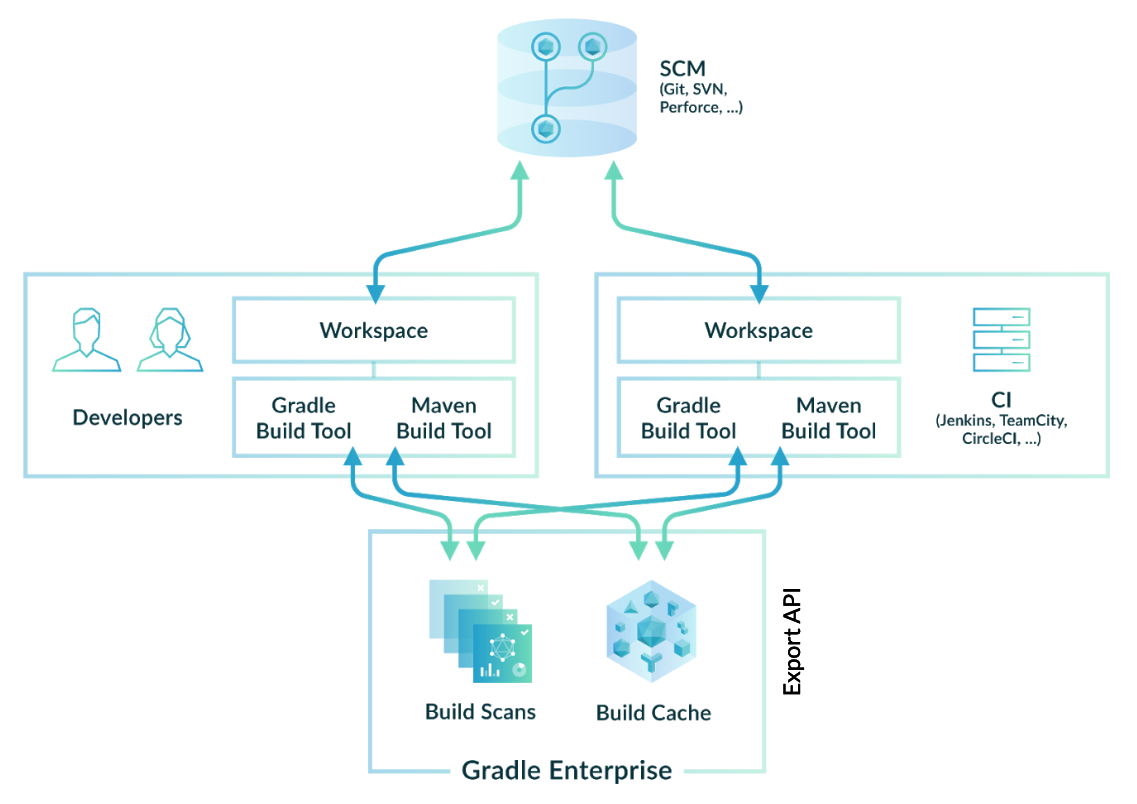
Why dependency management?
A long time ago …
> javac -d out *.java
> cd out/
> jar cf ../../lib/project1.jar *.class
> cd ../../project2
> javac -cp ../lib/project1.jar -d out *.classThen came tools
Helped you build and package
Did not handle dependencies
Download jars from project website
Lived in a
libdirectory or equivalentOften saved next to code in source control
Source vs published
Sources
(mostly) reliable
(often) slow
hard to temper with
hard to version
Source vs published
Binaries
Stable
Fast (pre-built)
Requires trusted sources
Not always metadata
Growing ecosystem
With the growing popularity of Java and the growth of its ecosystem, managing all dependencies of a project turns into a dependency chase.
Thus dependency management …
Ivy or Maven would take care of your dependencies
Libraries have known coordinates
Published to repositories, with metadata in addition of the binary
Automated the transitive aspect of dependency management
Metadata: Maven != Maven Central
Maven: a build tool
Maven POM: a metadata format
Maven repositories: Places where you can find binaries, with Maven metadata
And Gradle joins the party
Compatible with all of the previous options
libor custom repositoriesIvy metadata
Maven metadata
Gradle Module Metadata (since 5.3)
and more …
Demo
Getting dependencies
From a repository to your machine
Gradle attaches importance to the source of a dependency, its origin repository.
Gradle has lots of smarts in order to optimise the downloading of files.
Repositories
Order of repositories is important
Use repository filtering for partitioning sources
Avoid mavenLocal()
Not strictly a repository, but a cache for Maven
Sometimes contains partial module data, this will trip Gradle
Metadata and artifacts downloaded concurrently
How Gradle searches for binaries
Gradle knows where an artifact comes from
Get the SHA1 of the artifact (GET or HEAD)
Looks in its dependency cache if something at the same GAV has the same hash
If so, uses it
Can leverage local maven repository content instead of downloading
That is transparent, and different than having
mavenLocal()declared as a repository
Consequence: if you get a file from Maven Central, then you change the repository to JCenter, if the artifacts are the same, downloaded only once.
Core concepts
Definitions
Module
A piece of software that evolves over time
Has a group, name and version to identify it
Example:
org.slf4j:slf4j-api:1.7.2
Configuration
In the context of dependency management, and for most users:Named set of dependencies
Provides access to resolved modules and their artifacts
Example:
implementation
API and implementation

More bucket configurations
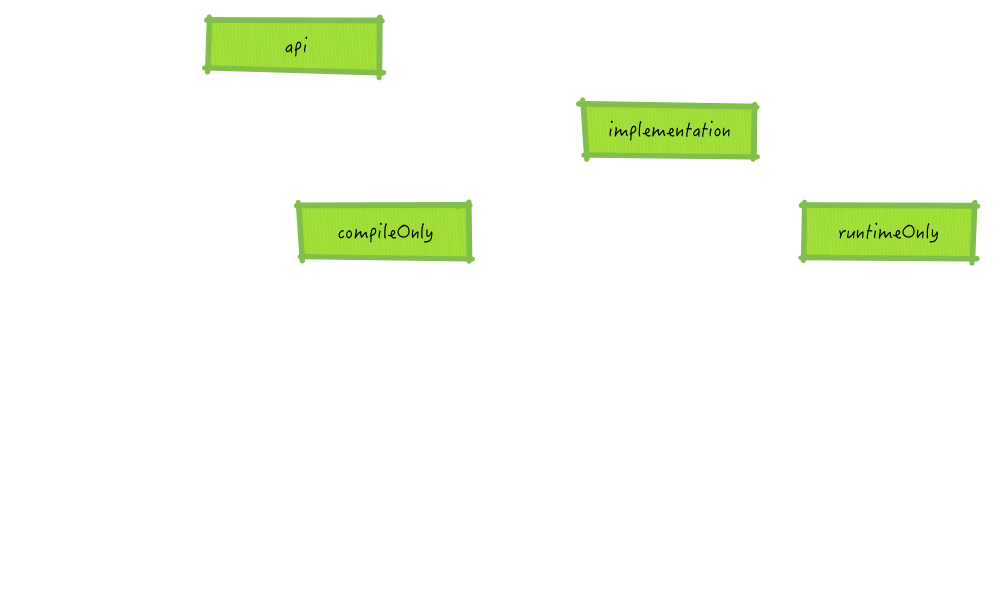
Bucket configurations relationship
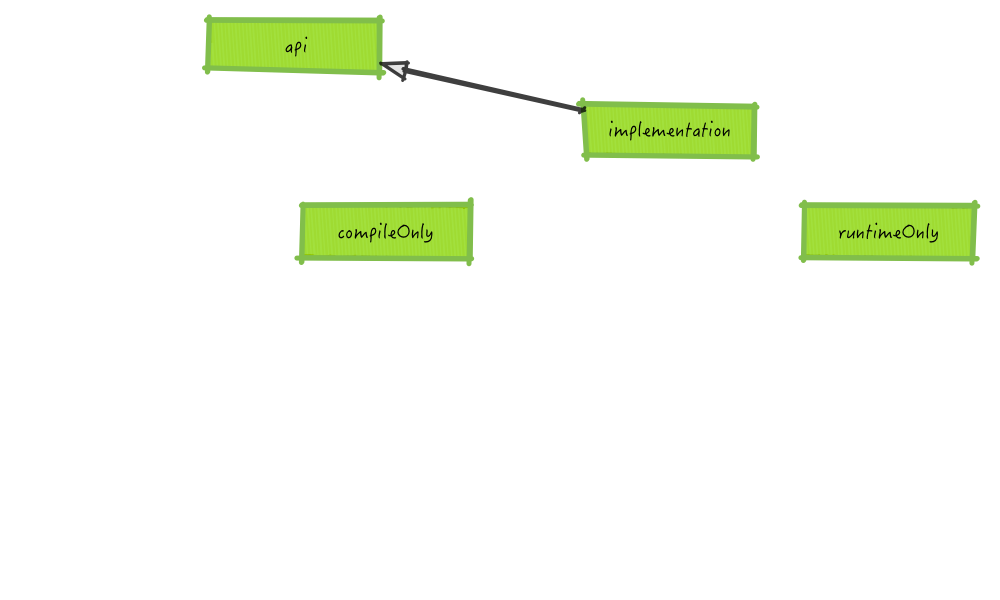
API vs implementation
To build a module, you need:
api,implementationandcompileOnlydependencies
To run a module, you need:
api,implementationandruntimeOnlydependencies
Classpath configurations
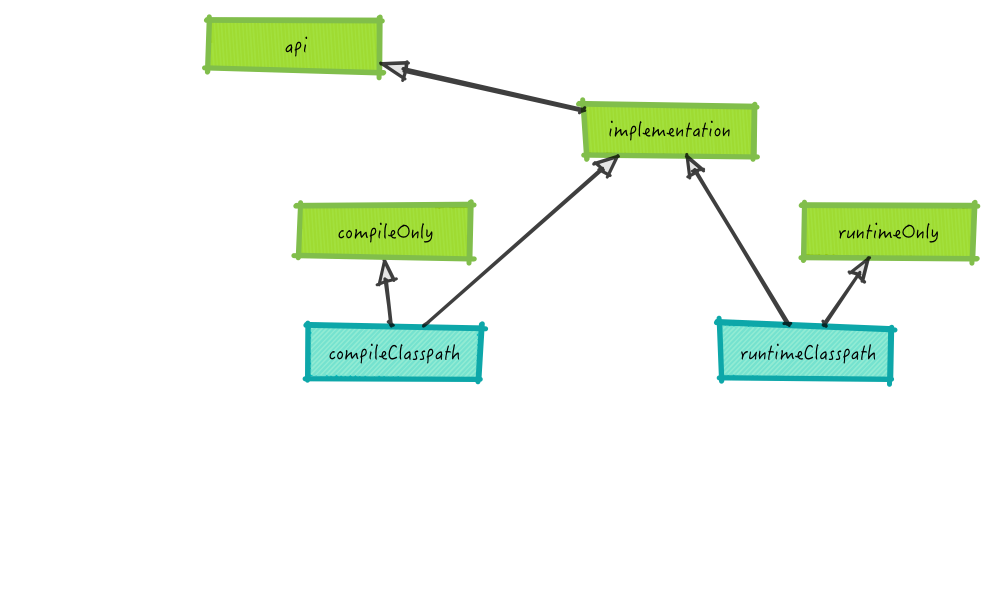
API vs implementation transitively
To build against a module, you need:
transitive
apidependencies
To run against a module, you need:
transitive
api,implementationandruntimeOnlydependencies
Elements configurations

Configurations
3 kinds of configurations
"buckets" of dependencies
resolvable configurations
consumable configurations
Buckets of dependencies
A named list of dependencies
canBeConsumed=false
canBeResolved=false
Resolvable configurations
Represents a consumer
For a specific usage (compiling, runtime, …)
Extends from one or more bucket(s)
canBeConsumed=false
canBeResolved=true
Consumable configurations
Represents a variant of a producer
Attaches artifacts
Extends from one or more bucket
canBeConsumed=true
canBeResolved=false
Matching consumers with producers
Gradle needs a way to perform the matching between consumers and producers.
Attributes and variants are the answer.
More definitions
Attribute
Named
Typed
Can have compatibility and disambiguation rules
Variant
A consumable form of a module
Declare artifacts and / or dependencies
Identified by its attributes and their values
Compilation against project

Compilation against project
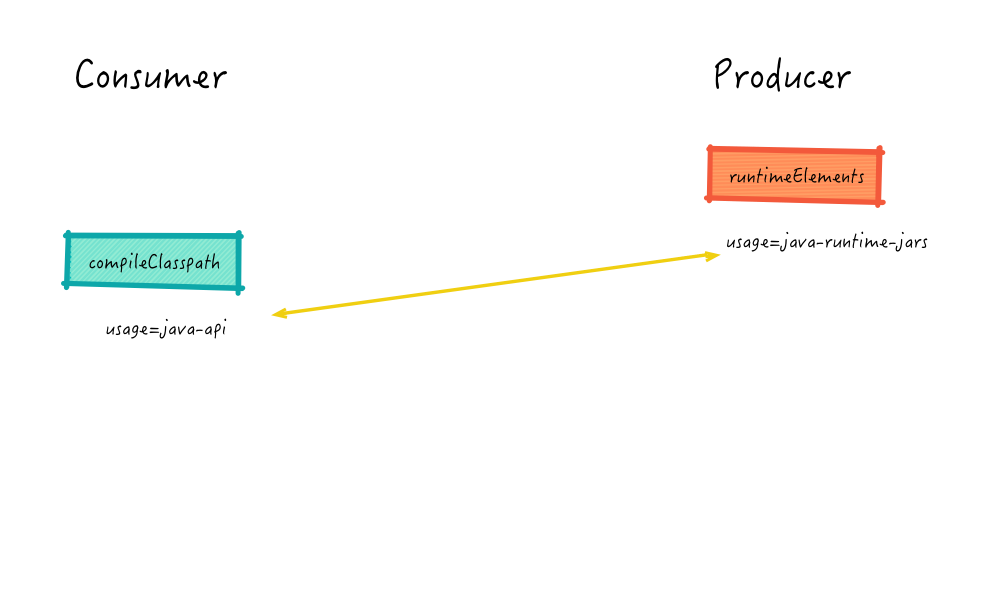
Compilation against project
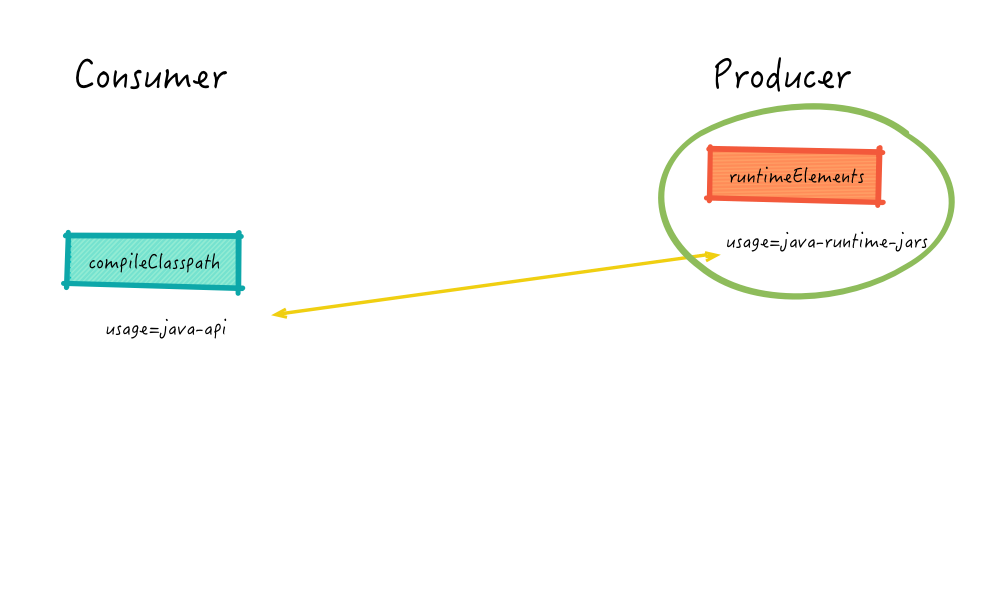
Compilation against project API

Compilation against project API
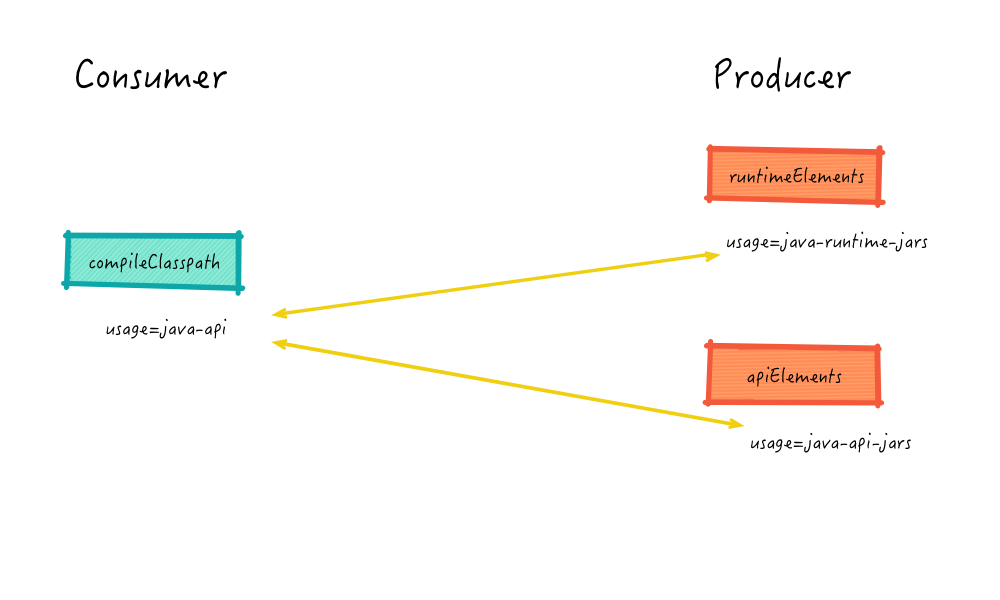
Compilation against project API
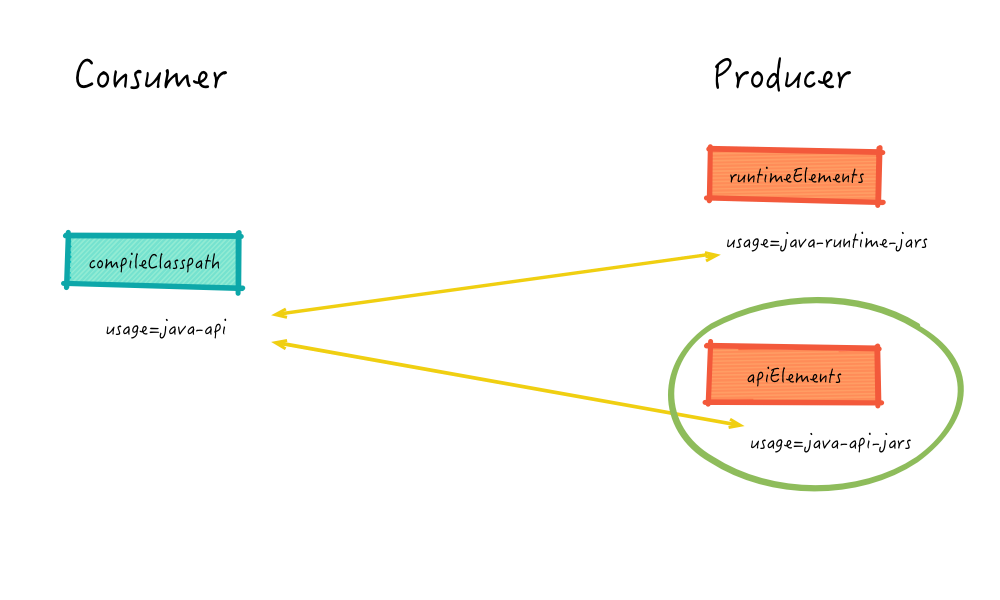
Runtime against project
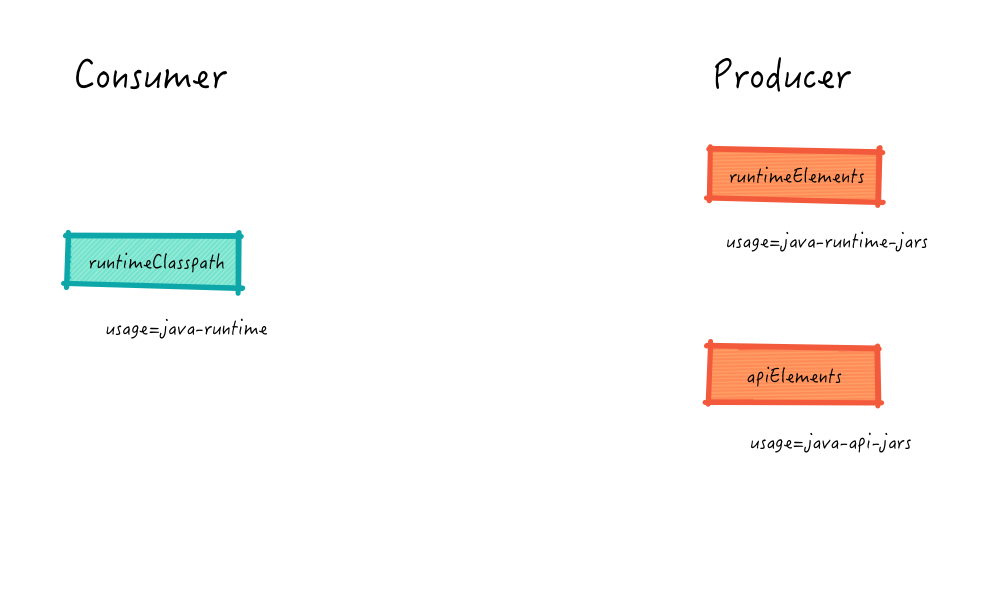
Runtime against project
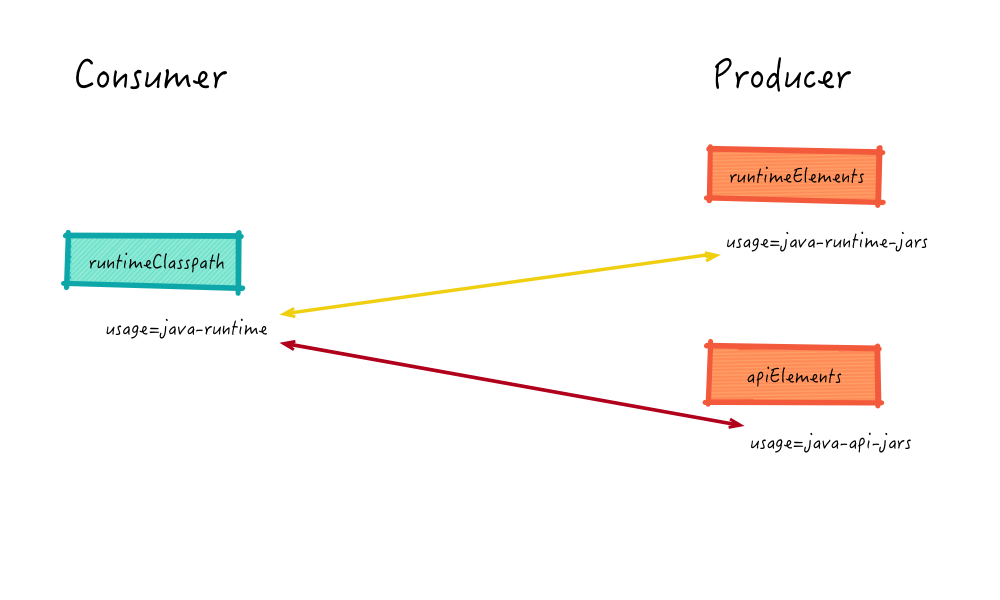
Runtime against project
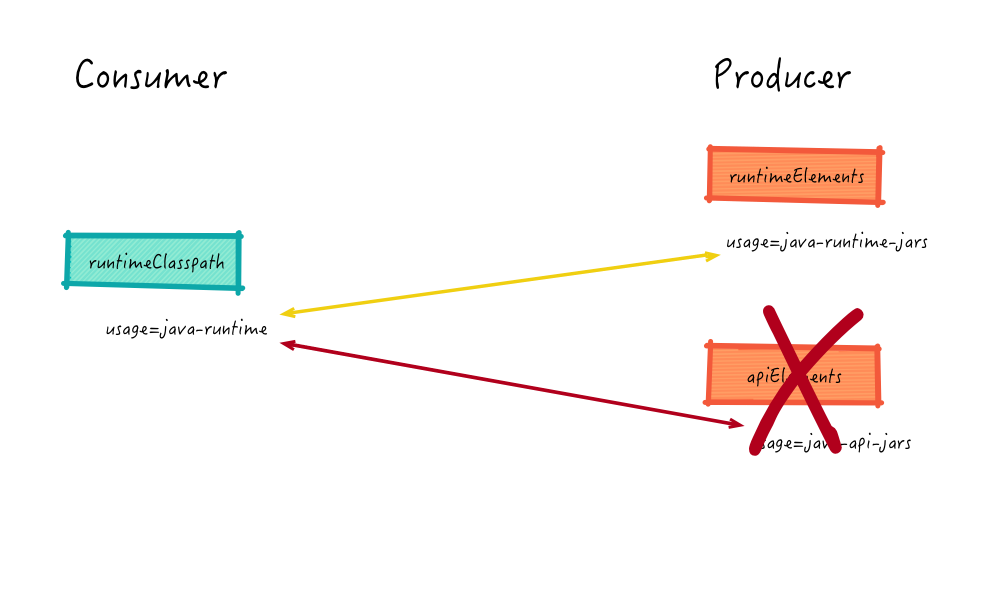
Runtime against project
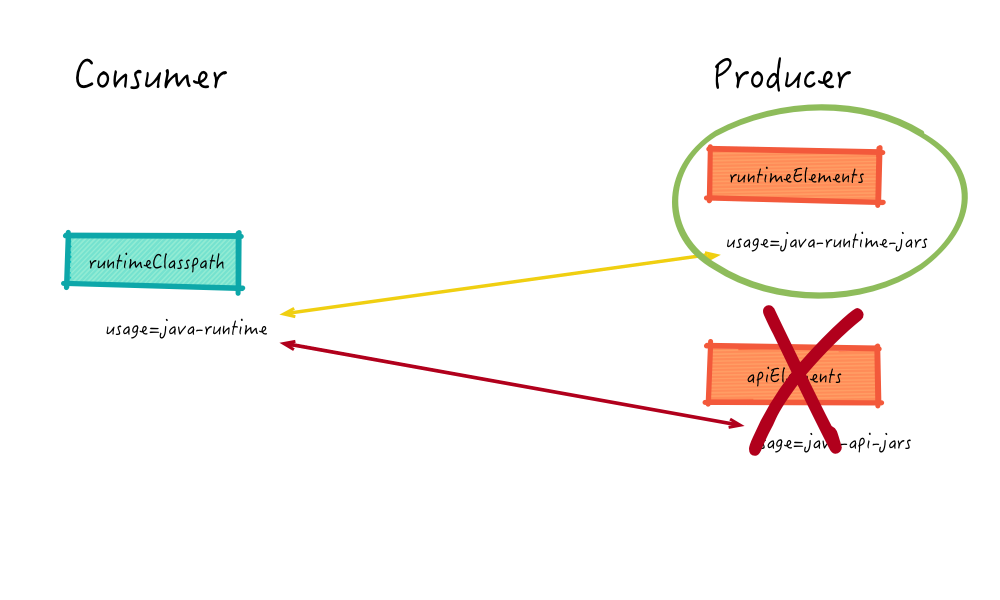
Against external dependency

Gradle attributes
org.gradle.usage: indicates the usage of a variantExample:
java-apiorjava-runtime
org.gradle.category: indicates the category of a componentExample:
libraryorplatform
org.gradle.dependency.bundling: indicates how dependencies are handledExample:
regularorembedded
Gradle JVM attributes
org.gradle.jvm.version: indicates the minimal JVM version compatibilityExample:
6,9or12
Usage of attributes
Can be declared on configurations
Defines an expected value on resolvable
Defines an exposed value on consumable
Can be declared on dependencies
Overrides the configuration value (if set)
Can be declared when retrieving artifact
Semantics and dependencies
Gradle has a strong modelling of dependencies:
Semantic difference between compilation and runtime
Semantic difference between building a library and building against a library
Ability for a module to produce more than one variant
Controlling dependency versions
Rich version constraints
Meaning of versions
What does it mean to say: "I depend on 1.1"
Does it mean it doesn’t work using 1.0?
Implicit statement: "I should work with 1.1+"
What if it’s not true?
Meaning of versions
Use
latest.release?Dependency on
1.2-beta-3: isbetaimportant?Dependency on snapshots…
Enter rich version constraints
dependencies {
implementation(project(":gitutils"))
implementation("info.picocli:picocli") {
version {
strictly("[3.9, 4.0[")
prefer("3.9.5")
}
because("Provides command-line argument parsing")
}
}Version constraints
Legacy notation (without
versionblock) translates torequirerequire: doesn’t accept any lower version, upgrades are acceptablestrictly: if any other version in the graph disagrees, failsprefer: weak constraint, if nobody else cares, choose this version
How to choose?

How to choose?
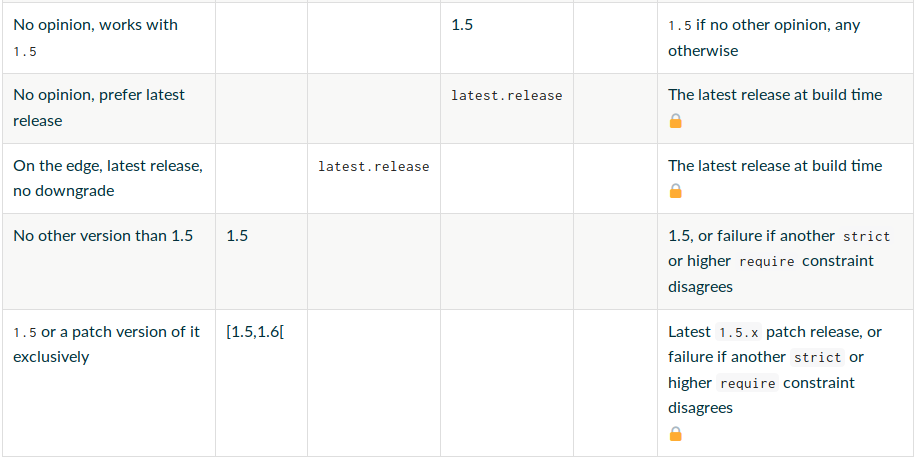
Special versions
Snapshots
Ranges (
[1.0, [,[1.1, 1.4], …)Head selectors (
latest.release,latest.integration)Cached to avoid too many repository lookups
Control over dynamic versions
configurations.all {
resolutionStrategy.cacheDynamicVersionsFor 0, 'seconds'
}Warning: significant impact on performance!
Control over dynamic versions
--refresh-dependencies: has impact only on dynamic/changing modulesAbsolutely no relationship with Maven local repository or Gradle artifact cache
Dependency locking
If you use dynamic versions ([1.0, [, 1.+, latest.release, …):
Builds become non reproducible
Solution: dependency locking
Dependency locking
Lock a single configuration
configurations {
compileClasspath {
resolutionStrategy.activateDependencyLocking()
}
}Dependency locking
Convenience for locking all configurations
dependencyLocking {
lockAllConfigurations()
}Controlling dependency versions: dependency constraints
Direct dependencies vs transitive dependencies
Should be used to tell something about the project itself
What you directly use in code
What if you need to say something about a transitive dependency?
Dependency constraints
A dependency constraint tells something about modules found in the graph
Doesn’t matter how deep in the graph they are
Can be used to upgrade transitives
Affects resolution result if and only if module seen in graph
dependencies {
constraints {
implementation("org.slf4j:slf4j-api:1.7.26")
}
}Dependency constraints
Can be used to implement recommendations
dependencies {
constraints {
implementation("org.slf4j:slf4j-api:1.7.26")
implementation("org.apache:commons-lang3:3.3.0")
}
dependencies {
implementation("org.slf4j:slf4j-api") // no version
}
}Dependency constraints
Participate in the graph
They do not override preferences
They introduce additional constraints on versions
Conflict resolution discussed in 2d part of webinar
Structuring your build
Use case: commons dependencies
Often subprojects in a repository have to share the same versions
How can we:
Define common dependency versions
Share the result
Meet the Java Platform plugin
A Java Platform defines a set of dependency constraints
May have different api and runtime constraints
Optionally defines dependencies
Step 1: define a Java Platform subproject
plugins {
`java-platform`
}
dependencies {
constraints {
api("org.slf4j:slf4j-api:1.7.26")
api("org.slf4j:slf4j-simple:1.7.26")
}
}Step 2: refactor subprojects
dependencies {
api(platform(project(":platform")))
implementation("org.slf4j:slf4j-api") // <-- no version here
}Step 3: extract versions
plugins {
`java-platform`
}
// May be moved to `buildSrc`
object Deps {
val slf4jVersion = "1.7.26"
}
dependencies {
constraints {
api("org.slf4j:slf4j-api:${Deps.slf4jVersion}")
api("org.slf4j:slf4j-simple:${Deps.slf4jVersion}")
}
}Publication
When published, platforms are similar to Maven BOMs
Actually published as BOMs for Maven consumers
and published "as is" for Gradle consumers
Wrap up
Documentation links
Request a personal demo of Gradle Enterprise at https://gradle.com/enterprise/contact
Sneak peak at Part 2
Handling version conflicts
Dealing with bad metadata
Dependency alignment
Capabilities
Resolution rules
…
To be confirmed: June 6th